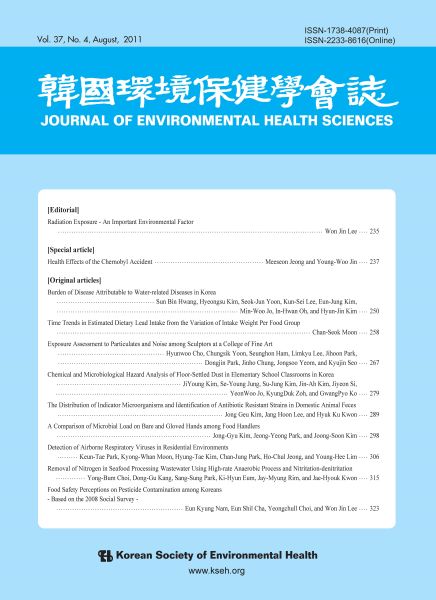- 영문명
- Exposure Assessment to Particulates and Noise among Sculptors at a College of Fine Art
- 발행기관
- 한국환경보건학회
- 저자명
- 조현우(Hyunwoo Cho) 윤충식(Chungsik Yoon) 함승헌(Seunghon Ham) 이임규(Limkyu Lee) 박지훈(Jihoon Park) 박동진(Dongjin Park) 정진호(Jinho Chung) 염종수(Jongsoo Yeom) 서규진(Kyujin Seo)
- 간행물 정보
- 『한국환경보건학회지』제37권 제4호, 267~278쪽, 전체 12쪽
- 주제분류
- 공학 > 환경공학
- 파일형태
- 발행일자
- 2011.08.30

국문 초록
영문 초록
Objectives: A great number of hazardous agents can be emitted from various types of art-creation in a fine arts
college, but little data on exposure assessment has been published. A variety of processes encompassing toxic
or non-toxic materials, tools, and components are involved in a sculptor work at a fine art college. The aim of
this study was to assess exposure levels to particulates and noise during sculpture classes in a college of fine arts.
Methods: Students in sculpture classes participated in this study. Mass, number, and surface area concentrations
of particulates, noise level, temperature and relative humidity were monitored by both personal and area
sampling during the tasks of metal, wood, and stone sculpting.
Results: The number and surface concentration of particulates was the highest in the task of wood sculpting,
followed by metal and stone work. The mass concentration of particulates was the highest in stone sculpting
(personal GM 3.0 mg/m3, GSD 3.0), followed by wood (personal GM 1.5 mg/m3, GSD 1.8) and metal work
(personal GM 0.95 mg/m3, GSD 1.51) in that order. Occupational exposure limits (OEL) for particulates depends
on the type of particulate. For wood dust, 86% (six subjects) of the personal samples and all area samples
exceeded the Korean OEL for wood dust (1 mg/m3), while 20% (two subjects) among stone sculpting students
were exposed above the Korean OEL (10 mg/m3). In contrast, metal sculpting did not exceed the OEL (5 mg/
m3). For noise level, metal sculpting students (Leq 95.1 dB(A) in the morning, 85.3 dB(A) in the afternoon) were
exposed the most, followed by stone sculpting (88.3 dB(A)), and wood sculpting (84.8 dB(A)) in that order.
Compared with the 90 dB(A) of the Korean OEL and 85 dB(A) of the American Conference of Governmental
Industrial Hygienists’ threshold limit value (ACGIH-TLV) for noise, 100% of the subjects (five subjects) and
area samples during metal sculpting in the morning session exceeded both OELs, but only three subjects (60%)
exceeded the ACGIH-TLV in the afternoon session. For stone sculpting, 50% (one subject) and 100% (two
subjects) exceeded the Korean OEL and ACGIH-TLV, respectively, but the area sample did not exceed either
OEL. During wood sculpting, two subjects (40%) exceeded ACGIH TLV.
Conclusions: This work evaluated the sculptors’ exposure to particulate matter and noise in fine art college, and
revealed a poor working environment for the participating students. Effective measures should be supplemented
by the administration of colleges.
목차
I. 서 론
II. 연구방법
III. 결 과
IV. 고 찰
V. 결 론
참고문헌
해당간행물 수록 논문
참고문헌
최근 이용한 논문
교보eBook 첫 방문을 환영 합니다!

신규가입 혜택 지급이 완료 되었습니다.
바로 사용 가능한 교보e캐시 1,000원 (유효기간 7일)
지금 바로 교보eBook의 다양한 콘텐츠를 이용해 보세요!


